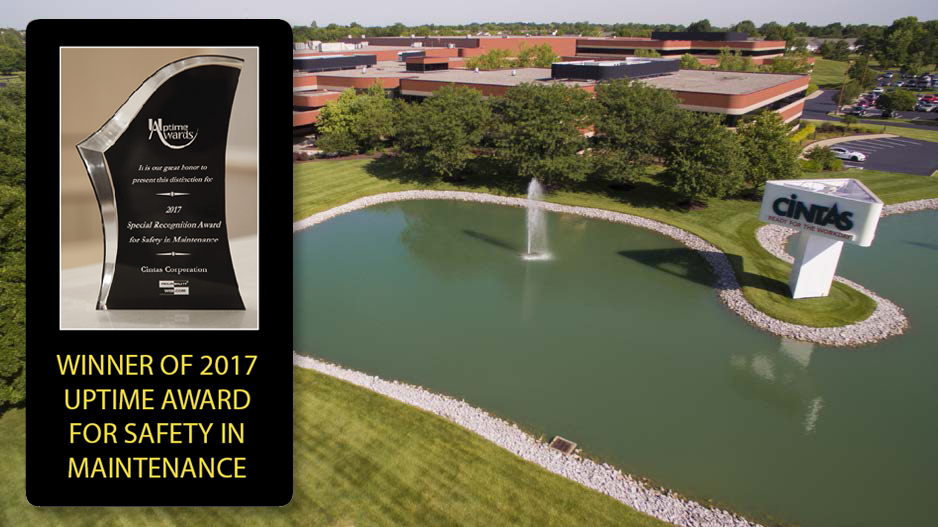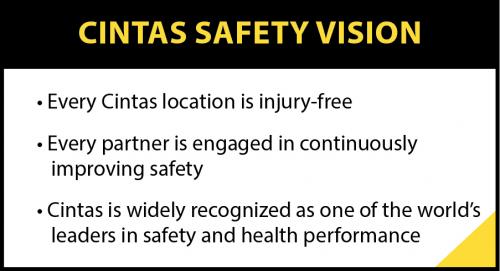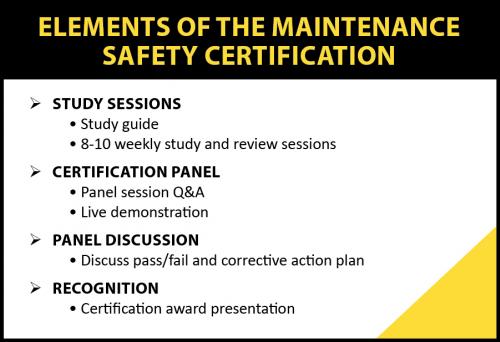Article Archive
Maintenance Safety Certification: Transforming Safety Training For Technicians
 |
Eric Ayanegui, CPMM, CRLDirector Operations Engineering Ph: 713-300-3088 |

“Safety must be much more than a subject we manage, it must be part of our corporate culture and a foundational part of everything we do as a company”
~ Scott Farmer, CEO, CINTAS
Cintas Corporation, which operates more than 400 facilities in North America, including six manufacturing companies and eight distribution centers, embarked on a mission to improve safety strategy, execution and results. This article follows the corporation’s journey to make safety part of its culture and a foundational part to everything it does.
About the Company
Headquartered in Cincinnati, Ohio, Cintas is a publicly held Fortune 500 company, traded over the Nasdaq Global Select Market under the symbol CTAS, and a component of the Standard & Poor’s 500 Index. The company provides more than one million businesses with a wide range of products and services to enhance their customers’ image and help its customers keep their facilities and employees clean, safe and looking their best. Products and services include uniforms, floor care, restroom supplies, first aid and safety products, fire extinguishers and testing, and training and compliance courses.
Beginning the Safety Journey
In 2003, the company hired its first safety professional to help improve safety strategy, execution and results. Since that first hire, Cintas has worked diligently to achieve CEO Scott Farmer’s vision that: “Safety must be much more than a subject we manage, it must be part of our corporate culture and a foundational part of everything we do as a company.”
The company assembled a team of safety professionals, including outside executive level safety consultants, to develop and implement world-class safety solutions for Cintas’s work environments to help reduce employee risk and improve safety processes.
To deliver its uniform rental service, Cintas operates more than 200 industrial laundry facilities and employs more than 1,000 maintenance technicians. Many of the company’s safety programs and solutions affect these technicians as they work hard to maintain equipment in operating condition. Technicians attend mandatory regulatory safety training (e.g., lockout-tagout (LOTO), hazard communication (HAZCOM), electrical safety, etc.), as well as company required safety training (e.g., heat stress, ergonomics, safe lifting, etc.).
Many company resources are devoted to helping technicians understand the risks of their jobs and teaching them how to perform their jobs more safely.
Introducing Maintenance Safety Certification
In 2011, Cintas improved its program by updating its maintenance training to utilize teaching methodologies that would help impart a higher level of knowledge and understanding of all aspects of on-the-job safety.
A maintenance safety certification development team was established. The team consisted of seasoned safety and engineering employees who reviewed safety topics and training programs affecting maintenance technicians, including safety manuals, checklists and other materials. The content was evaluated for relevance and importance. Once a list of safety topics was developed, the team drafted documents for the new maintenance safety certification.
Certification Documents
The documents include a detailed list of questions and answers, divided by safety topic, for use by technicians to study and internalize. The same list is used by a certification panel to evaluate the technicians. The documents also include a series of complex troubleshooting scenarios for use during a Q&A section, as well as scenarios for use during a live demonstration section.
Certification Structure
The maintenance safety certification process is based on other existing company certification processes, which include detailed study guides, study and review sessions and a certification panel consisting of leaders with knowledge of the certification subject.
The maintenance safety certification includes four sections:
1. Study and Review Sessions
- Study guide
- 8-10 weekly study and review sessions
2. Certification Panel
- Panel session Q&A
- Live demonstration
3. Panel Discussion
- Discuss pass-fail and corrective action plan
4. Recognition
- Certification award presentation

Study and Review Sessions
Technicians are provided a detailed study guide and are included in a weekly review conference call. The call is directed by corporate safety and engineering employees, serving as an accountability method to help technicians keep pace with their study plan and remain on track for their certification. During the call, employees review and discuss material from the study guide to encourage a full and in-depth understanding of each point outlined. Technicians participate in eight to 10 weekly study and review sessions.
Certification Panel
The certification panel includes the plant’s general manager, plant manager, human resources manager, corporate engineer, and corporate safety and health coordinator.
During the panel session, panel members randomly select and ask 50 questions from the study guide. The panel session is closed book; no notes or documents are allowed. Technicians must know detailed information from the study guide and be able to articulate detailed accurate responses. Technicians must respond to all questions correctly to pass.
After the 50 question section, the certification process includes a scenario section. Technicians are verbally presented with four scenarios randomly selected from a group of eight options based on real-life troubleshooting incidents, each with an elevated safety risk. The scenarios are based on these high-risk categories: LOTO, electrical safety, confined space and elevated work.
The scenarios presented include complex technical issues that require multiple safety precautions and procedures to be followed in order to safely and successfully complete the repair. Technicians are expected to verbally describe, step-by-step and in detail, how they would proceed. The certification panel is provided with documented detailed steps that include all safety requirements of the scenario. As the technician verbalizes his or her response, the panel closely monitors responses and looks for all required safety cues.
At the conclusion of each scenario response, the certification panel asks the technician what could happen if the necessary safety steps were not followed. At this point, the panel is looking for the technician to internalize the consequences to his or her own safety and well-being and verbalize this understanding of personal safety responsibility.
Once the panel and scenario sessions are complete, the certification process changes venue from a conference room to the production floor. There, the certification panel verbally presents a demonstration scenario to the technician, who is expected to take this information and begin to troubleshoot. During this time, the certification panel observes all activity by the technician. Panel members evaluate if the technician follows all necessary safety requirements, completes necessary safety documentation, uses proper safety tools and follows appropriate safety protocols.
Panel Discussion
Once the demonstration section is complete, the certification panel reconvenes to review and discuss the technician’s performance during all sections of the process to determine pass-fail for each section.
The technician is required to retest any failed section(s). If a technician fails a section, a customized and individual retraining plan is developed by the panel. This recertification plan may include review, study and recertification of failed sections and may also include escalating consequences, such as a revocation to perform certain tasks during the retraining period.
Recognition
Once technicians successfully complete all sections of the certification, they are presented with a personalized maintenance safety certification award to emphasize this important professional development achievement. In addition to the trophy presentation, each location is encouraged to plan a recognition event for the technicians to celebrate their achievement among their peers and other plant personnel, such as management and machine operators.
Cintas made the fundamental decision that successful completion of maintenance safety certification would become a condition for employment for its technicians. Therefore, collaboration with its human resources department was critical in the development and review of each element of the certification. Careful thought was given to ensure that the support and structure existed for technicians to be able to study and prepare for the certification while at work. Rules for pass-fail were carefully reviewed and rules and documentation for retraining plans were documented.
Implementing a Pilot Certification Program
In order to properly assess the effectiveness and employee impact of the maintenance safety certification process, Cintas chose to pilot this process across a limited number of selected locations. Locations were selected to ensure a broad spectrum of technicians were included in the pilot.
Based on observations and results from the pilot certifications, the process was slightly modified and rules were established. The process was improved to allow technicians to have a study guide that included complete and accurate answers from the outset. This eliminated technicians learning incorrect or incomplete information. The company also established a waiting period of six months before a technician is added to the certification list. This six-month period gives technicians who are new to the company the appropriate amount of time to learn and assimilate to Cintas. As with other company certification programs, it was established that technicians would be certified only once. Annual safety retraining would continue to be handled through the regular safety training calendar, including annual retraining on high risk topics like LOTO, electrical safety, confined space and elevated work.
During the pilot, the company also realized that most of the tenured technicians had not studied technical material for many years, some since high school, in the military, or vocational technical school. The maintenance safety certification process revived their test preparation and study habits. The certification level of this program definitely elevated the level of preparedness necessary to have a positive outcome.
Obtaining Executive Support
One key element for the success of the maintenance safety certification was executive support. The certification development team counted on the support of a senior executive to serve as the executive sponsor of the project. This executive sponsor provided executive level input to ensure certification met expectations. In addition, the executive sponsor provided regular updates of the project and its importance to all other senior executives.
Conducting the Final Rollout
Once the maintenance safety certification process was ready for company-wide rollout, appropriate marketing was done within the company to establish support and create buy-in. A video message was professionally created and shared with every management team member and technician. In the video, the executive sponsor introduced and described the certification’s elements. The video also included a series of FAQs that the team had collected during the pilot certification. This approach made implementation and rollout easier since all company stakeholders understood the importance of the program.
Results
Since the original certification rollout, Cintas has certified over 700 technicians, with about 87 percent passing on their first attempt, about 10 percent passing on the second attempt (testing on failed sections) and approximately three percent failing on the second attempt.
Additional Benefits Realized
The maintenance safety certification became a transformational program in several ways. The program raised the profile and importance of safety training for technicians by elevating the training to certification level. This meant a higher degree of difficulty since deep understanding of the material was required. The program also changed the way technicians approached test preparation. Besides the required weekly study and review sessions, technicians would huddle as a team to study and quiz each other. Others would include family members in their preparation, often collaborating with loved ones to review flashcards and other certification content. This brought about an interesting dynamic that the company had not expected – family members and loved ones engaging in safety-related conversations with the technicians. These conversations often produced some very meaningful insights for the technicians because, suddenly, they were having to answer to their wife, son, or daughter about whether or not they follow LOTO or consistently wear personal protective equipment to guard against injury.
The certification process also became a transformational experience for members of management that participated on the certification panel. These management team members experienced high levels of excitement and pride as they witnessed their technicians correctly articulate answers to difficult safety questions, correctly address detailed responses to challenging troubleshooting scenarios and show command of all detailed safety steps and requirements necessary during the tough demonstration section of the certification.

Most importantly, the maintenance safety certification became a transformational experience for the technicians. In the end, technicians obtained a significantly higher level of knowledge and understanding of the safety requirements of their jobs. They now know the “why” behind the importance of each safety element that impacts their job.
Upon successful completion of their certification, many were elated they were able to achieve success in obtaining certification. All the technicians experienced a sense of deep professional pride as they were presented with their certification trophies, often in front of the entire plant staff. Many technicians have expressed to company officials that this certification program was the most comprehensive and impactful safety program they had ever experienced. For many, this program is reassurance that the company cares deeply and sincerely about their safety.
About the Author
Eric Ayanegui, CRL, CPMM, is a technical leader at CINTAS Corporation, directing engineering, reliability, quality and safety initiatives in 210 industrial sites across North America and China. He is a founding member of CINTAS Corporate Safety team and a member of the CINTAS Corporate Executive faculty teaching reliability. Eric has over 20 years of experience in the industrial laundry industry.
Advertisement

